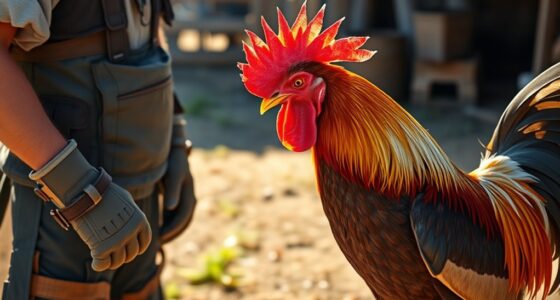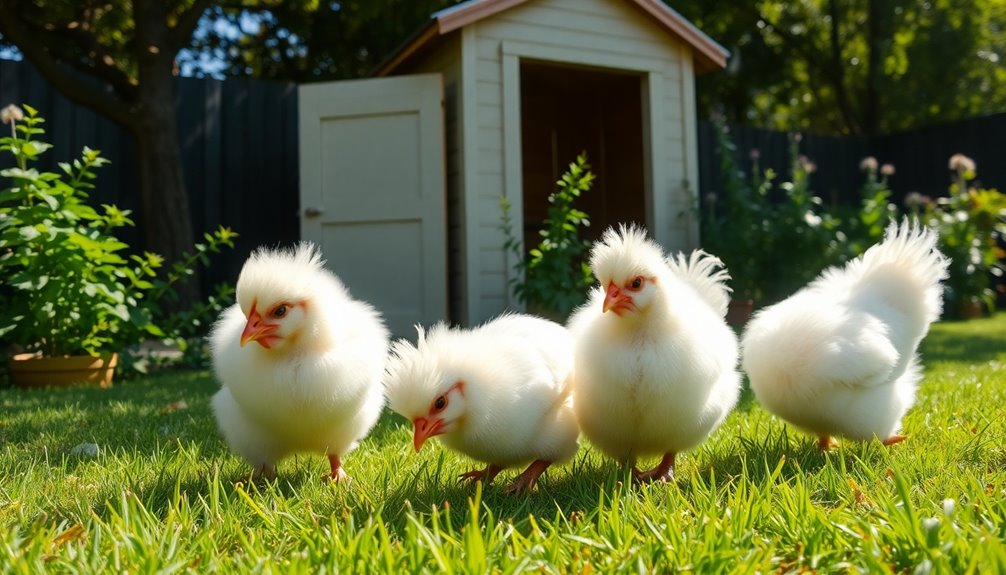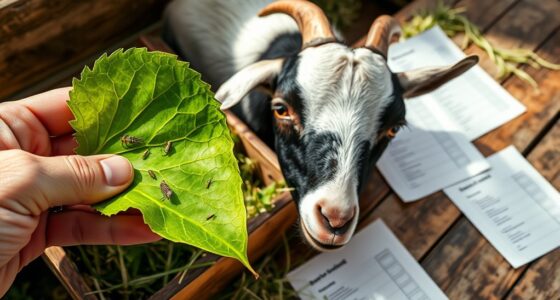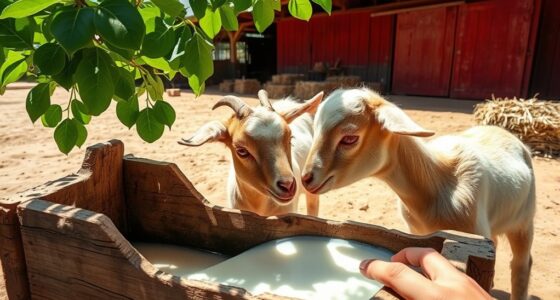To care for newborn animals in cold weather, monitor them closely for signs of cold stress like lethargy, pale gums, or shivering. Keep their environment warm and draft-free with well-insulated bedding, and elevate their nest off cold surfaces. Use appropriate heating devices safely to maintain temperatures around 85-90°F, and provide nutrient-dense food to boost their energy. Ensuring proper climate control and hygiene is essential—continue exploring these tips to keep your young animals safe and healthy.
Key Takeaways
- Monitor newborns closely for signs of cold stress, such as lethargy, weak appearance, or pale gums.
- Provide a well-insulated, dry nest with bedding like straw or blankets to retain heat.
- Use safe, adjustable heating devices like heat lamps or pads to maintain temperatures around 85-90°F.
- Ensure proper nutrition with high-calorie feeds and frequent feeding to support body heat regulation.
- Limit exposure by keeping animals indoors or sheltered, regularly checking their environment and body temperature.
Recognizing the Signs of Cold Stress in Newborn Animals
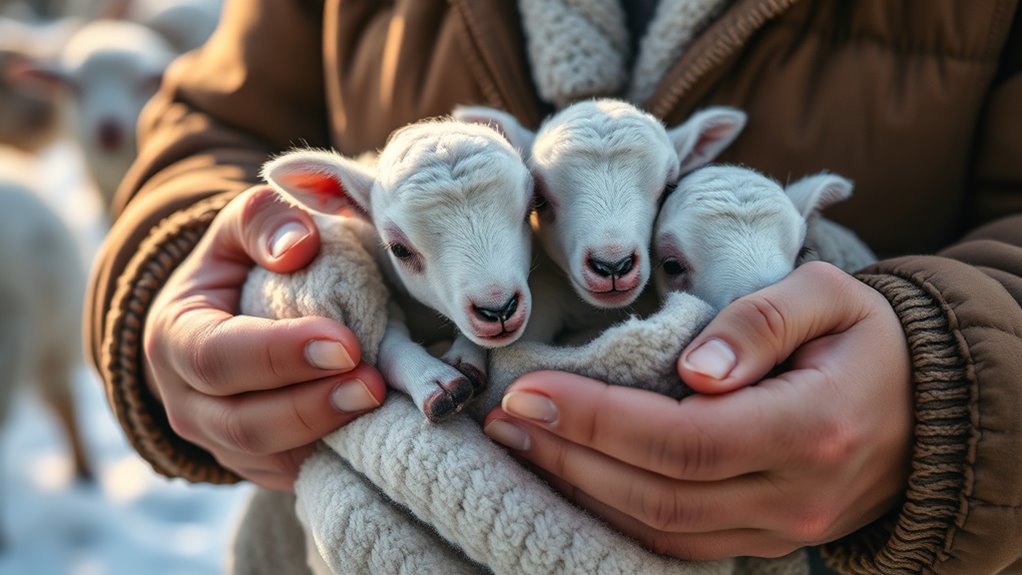
Newborn animals are highly vulnerable to cold stress, especially when their tiny bodies struggle to regulate temperature. You need to pay close attention to their behavior and physical cues. If they become lethargic, stop nursing, or appear weak, these are signs they’re feeling cold. Shivering is a common response, but it’s not always obvious in very young animals. Look for pale or bluish gums and extremities, which indicate poor circulation caused by cold stress. Keep an eye on their body temperature—if they feel cool to the touch, that’s a warning sign. Rapid breathing and difficulty staying alert also signal trouble. Recognizing these signs early helps you intervene quickly and prevent further health issues. Monitoring core body temperature is essential for assessing their condition effectively. Always monitor newborns closely during cold weather conditions.
Creating a Warm and Safe Environment for Newborns
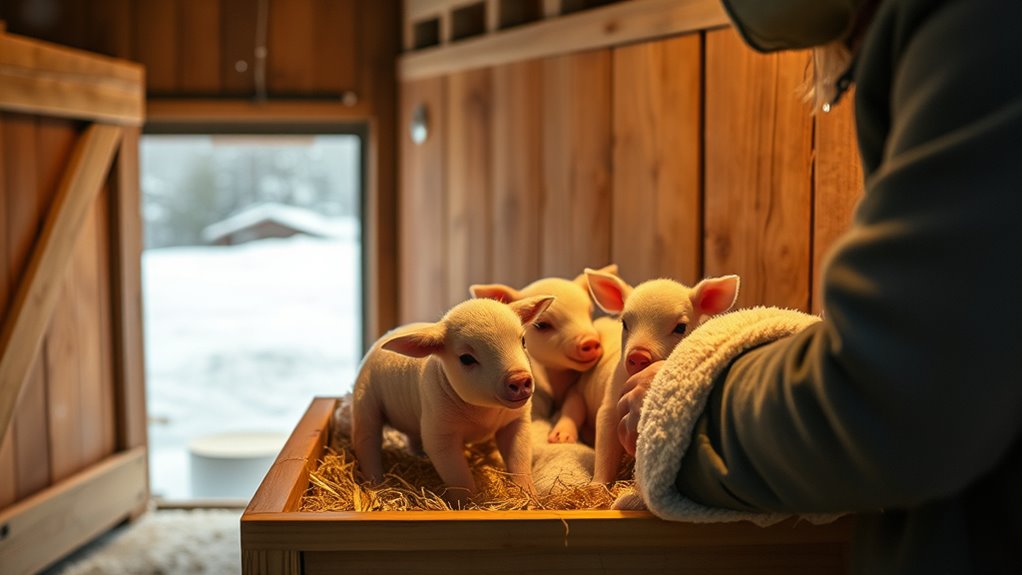
To keep newborn animals warm and safe, you need to focus on creating a well-insulated nest area. Use heating devices carefully to avoid burns or fires, and always monitor the temperature to prevent it from dropping or rising too much. Maintaining a steady, comfortable temperature is key to helping them thrive in cold weather. Utilizing modern heat pump technology can provide consistent and quiet warmth, ensuring a stable environment for newborns.
Insulate Animal Nest Areas
Creating a warm and safe environment for newborn animals starts with properly insulating their nest areas. You want to prevent heat loss by adding bedding materials like straw, hay, or shredded paper, which trap air and retain warmth. Guarantee the nest is enclosed enough to shield against drafts while still providing ventilation. Elevate the nest off cold ground using pallets or similar supports, reducing contact with cold surfaces. Cover the top with additional insulating materials to block wind and cold air from entering. Regularly check the insulation to make sure it remains dry and fluffy, as dampness reduces its effectiveness. Proper insulation helps maintain a stable temperature, giving newborns a cozy space to grow and thrive despite outside cold. Additionally, incorporating professional services can ensure the insulation setup is optimized for safety and effectiveness.
Use Heating Devices Safely
After insulating the nest area to retain warmth, the next step is guaranteeing the environment remains consistently heated without posing risks. Use heating devices designed for animal care, such as heat lamps or heated pads, and always follow the manufacturer’s instructions. Keep the heat source at a safe distance to prevent burns or overheating, and avoid placing them directly under or on top of the nest. Never leave heating devices unattended for long periods, especially when unsupervised. Use a thermostat or adjustable temperature control to maintain a steady, appropriate temperature. Regularly check the nest to ensure the heat source is functioning correctly and the environment isn’t becoming too hot. Safety comes first; an overheated space can be just as dangerous as cold conditions. Incorporating vintage-inspired heating equipment or accessories can also add to the comfort and aesthetic of the environment while ensuring safety.
Maintain Consistent Temperature
Maintaining a consistent temperature is essential for the health and survival of newborn animals, especially in cold weather. Fluctuations can cause stress or hypothermia. To keep them safe, focus on these key steps:
- Monitor the environment: Use a thermometer to ensure the temperature stays between 85-90°F (29-32°C) during the first week.
- Adjust heating sources: Add or remove heating devices as needed to uphold steady warmth without overheating.
- Create insulation: Use soft bedding like straw or blankets to help trap heat and insulate the area from drafts.
Choosing the Right Heating Equipment and Placement
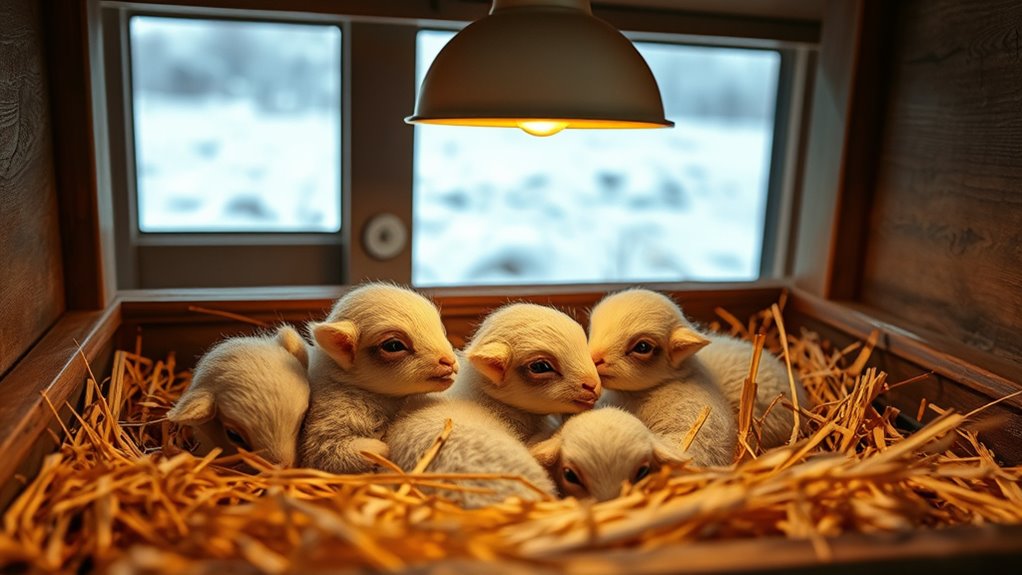
Choosing the right heating equipment and placement is crucial to keeping newborn animals warm and safe in cold weather. You need reliable heat sources that provide consistent warmth without overheating. Use equipment like heat lamps, heating pads, or infrared heaters, but guarantee safety by avoiding open flames. Position the heat source where it won’t cause drafts or direct contact with animals. Proper placement ensures even warmth and prevents injury. Keep the equipment elevated and secure to avoid accidental tipping. Here’s a quick guide:
| Equipment | Placement Tips | Safety Precautions |
|---|---|---|
| Heat Lamp | Hang above the bedding | Keep out of reach, avoid overheating |
| Heating Pad | Under bedding, away from water | Use thermostats, check regularly |
| Infrared Heater | Point at bedding area | Keep clear of flammable materials |
Choose wisely to create a safe, warm environment. Proper equipment placement and safety measures are essential for the well-being of young animals.
Ensuring Proper Nutrition to Support Thermoregulation
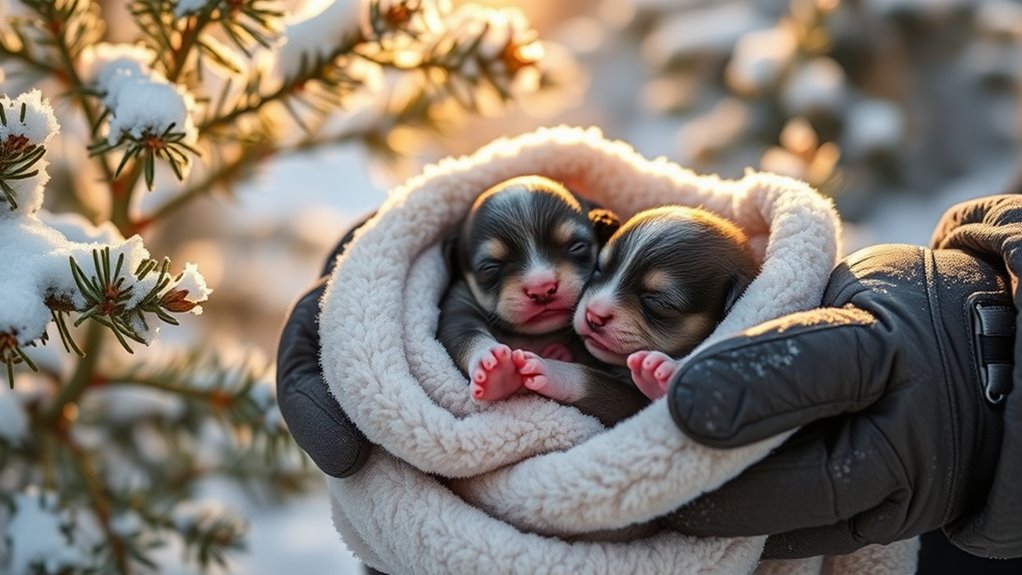
Proper nutrition is essential for newborn animals to effectively regulate their body temperature in cold weather. You need to provide a balanced diet that supports energy needs and boosts their immune system. To do this, focus on three key aspects:
- Offer high-calorie, nutrient-dense feeds to help generate body heat.
- Ensure frequent feeding schedules to prevent energy depletion.
- Supplement with vitamins and minerals, especially those supporting immune health, like zinc and vitamin E.
- Monitoring digital literacy programs can help caregivers better utilize technology and resources for proper care.
Monitoring and Maintaining Optimal Temperature Conditions
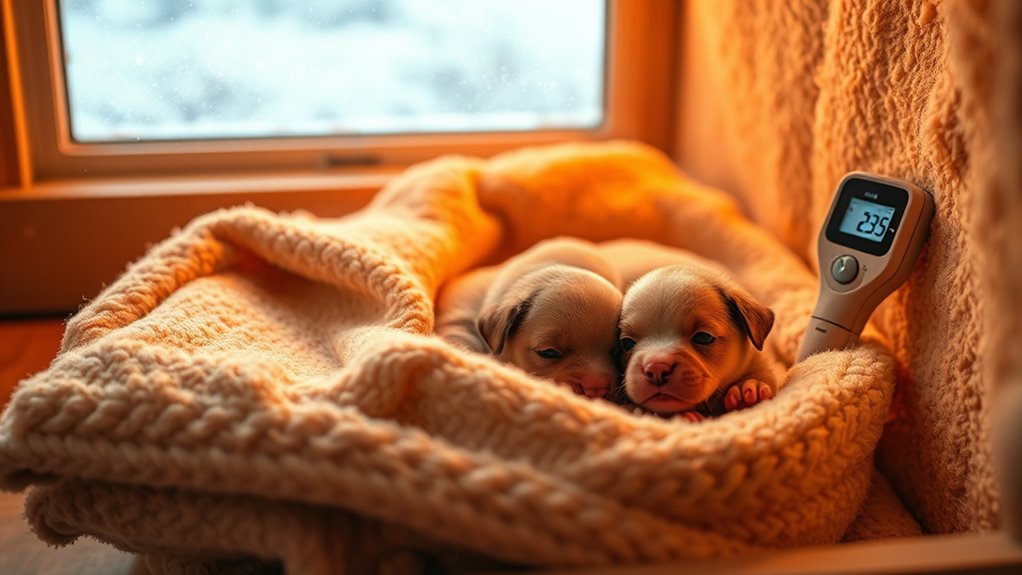
To keep your newborn animals comfortable, you need to monitor their temperature regularly with a reliable thermometer. Make sure they have warm bedding and adjust heating sources as needed to prevent chills. Staying attentive to these details helps make certain their safety and proper development in cold weather. Additionally, ensure the heating devices and enclosures are properly installed and maintained to prevent fire hazards and ensure consistent warmth.
Use Thermometers Regularly
Regularly using thermometers is essential to guarantee newborn animals stay at a safe and comfortable temperature. By checking temperatures often, you can catch any drops early and make adjustments quickly. Here are three ways to make this easier:
- Place a reliable digital thermometer in the animals’ environment to monitor ambient temperature.
- Use a rectal thermometer for precise readings of individual newborns, especially if they seem lethargic or cold.
- Record each reading daily to track changes and identify patterns that might require intervention.
- Utilizing accurate thermometers ensures reliable readings, which are crucial for maintaining optimal conditions.
Consistent monitoring helps you maintain a stable environment, preventing heat loss and ensuring suitable growth. Don’t rely on guesswork—accurate, regular thermometer checks are your best tool for keeping newborn animals healthy in cold weather.
Provide Warm Bedding
Ensuring newborn animals stay warm begins with providing them with cozy, insulated bedding. Use soft, clean materials like straw, shredded paper, or blankets to create a comfortable base. Regularly check the bedding’s temperature and dryness, replacing it when it becomes damp or dirty. Proper bedding helps retain body heat and prevents drafts. To emphasize its importance, consider this comparison:
| Insufficient Bedding | Well-Insulated Bedding |
|---|---|
| Cold, damp, uncomfortable | Warm, dry, cozy environment |
| Increased risk of hypothermia | Maintains ideal warmth |
Always monitor the bedding’s condition and adjust as needed to ensure your newborns stay warm, safe, and comfortable. Proper bedding is key to their survival in cold weather. Maintaining a consistent temperature is essential for preventing hypothermia and supporting healthy development.
Adjust Heating Sources
Maintaining the right temperature for newborn animals requires careful monitoring and adjustment of heating sources. You want to guarantee they stay warm without overheating. To do this effectively:
- Check the temperature regularly with a reliable thermometer, aiming for around 85-90°F for most newborns.
- Adjust heat sources like heat lamps or heating pads to maintain a consistent, safe temperature. Keep them at a safe distance to prevent burns.
- Observe the animals’ behavior; if they huddle closely or seek warmth, increase the heat slightly. If they spread out or seem restless, lower the temperature.
- Consider proper ventilation to ensure good air quality and prevent overheating or humidity buildup.
Additional Tips for Protecting Vulnerable Young Animals
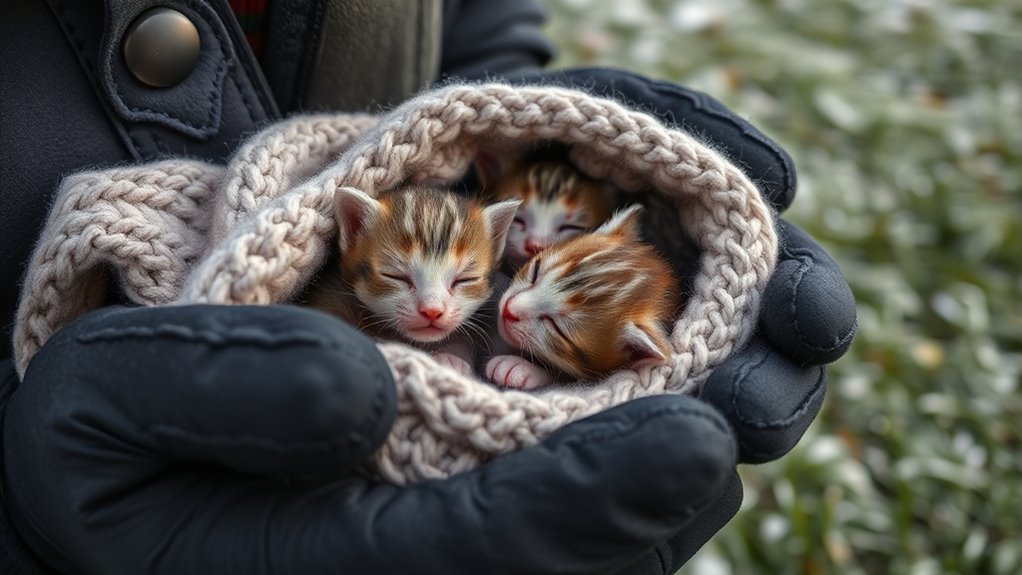
When caring for vulnerable young animals in cold weather, it’s essential to provide extra protection to prevent hypothermia and frostbite. Keep their environment warm and dry at all times. Use insulated bedding like straw or blankets, and change it regularly to avoid dampness. Limit their exposure to the cold by keeping them indoors or in a sheltered area. Monitor their body temperature using a thermometer; if it drops below normal, warm them gradually. Make sure they have easy access to fresh water that isn’t frozen. Avoid drafts and sudden temperature changes. Additionally, provide energy-rich food to support their growth and immune system. By taking these extra precautions, you help ensure their safety and health during harsh weather conditions.
Frequently Asked Questions
How Can I Tell if a Newborn Animal Is Too Cold to Survive?
You can tell if a newborn animal is too cold by feeling its body. If it’s cold to the touch, especially around the ears, paws, or tail, it’s a sign they’re too cold. Observe their behavior—if they’re weak, lethargic, or not moving much, they might be hypothermic. Keep them warm immediately by gently warming their environment and contacting a vet if conditions worsen.
What Are the Common Mistakes to Avoid When Heating Animal Enclosures?
You should avoid placing heat sources directly against enclosures, like a space heater close to bedding, which can cause burns or overheating. For example, a farmer once used a heat lamp too close to newborn piglets, resulting in burns. Always position heaters safely, use thermostats to regulate temperature, and make certain good ventilation. Keep the enclosure’s temperature steady and avoid sudden temperature changes that can stress or harm the animals.
How Often Should I Check the Temperature Inside the Animal’s Habitat?
You should check the temperature inside the animal’s habitat at least twice daily, morning and evening. During colder months, monitor more frequently to guarantee it stays within a safe range. Use a reliable thermometer and adjust heat sources as needed. Keep an eye on your animals for signs of discomfort, and make sure their environment remains consistently warm and cozy to prevent cold stress.
Are There Natural Remedies to Help Newborns Tolerate Cold Weather Better?
You can try natural remedies like providing warm, nutrient-rich broths or adding gentle herbal supplements known for boosting immunity, like echinacea or thyme, if appropriate for the species. Making sure they stay dry and protected from drafts also helps. Keep their environment warm with natural insulation such as straw or hay. Always consult a veterinarian before introducing any remedies to ensure they’re safe and suitable for your newborn animals.
What Signs Indicate That a Newborn Animal Is Overheating?
You’ll notice signs of overheating in a newborn animal if it becomes excessively panting or sweating, shows rapid or labored breathing, and has warm or flushed skin. Its movements might become restless or uncoordinated. If you see lethargy, drooling, or its body feels unusually hot to the touch, these are signs it’s overheating. Act quickly by cooling the animal and removing it from direct heat sources to prevent further issues.
Conclusion
By paying close attention and taking proactive steps, you can create a cozy haven for your newborn animals, much like wrapping them in a warm blanket of care. Keep an eye on their signs of cold stress, provide the right warmth and nutrition, and monitor conditions regularly. With your loving effort, you’ll help these tiny lives thrive, turning a chilly challenge into a warm success story. Remember, your care is the gentle sunshine they need to grow strong.



